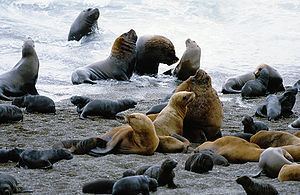Type Natural Reference 937 Province Chubut Province Designated as world heritage site 20 July 2012 | Criteria x Location Argentina Inscription 1984 (8th Session) | |
 | ||
Official name Valdes Peninsula Wetlands UNESCO region Latin America and the Caribbean | ||
The Valdes Peninsula (Spanish: Península Valdés) is a peninsula on the Atlantic coast in the Biedma Department in the north east of Chubut Province, Argentina. Around 3,625 km2 (896,000 acres; 1,400 sq mi) in size (not taking into account the isthmus of Carlos Ameghino which connects the peninsula to the mainland), it is an important nature reserve which was listed as a World Heritage Site by UNESCO in 1999.
Contents
Map of Valdes Peninsula, Chubut Province, Argentina
Geography
The nearest large town is Puerto Madryn. The only town on the peninsula is the small settlement of Puerto Pirámides. There are also a number of estancias, where sheep are raised.
Most of the peninsula is barren land with some salt lakes. The largest of these lakes is at an elevation of about 40 m below sea level (see extremes on Earth), until recently thought to be the lowest elevation in Argentina and South America (the lowest point actually being Laguna del Carbón, Argentina).
Climate
Valdes Peninsula has a semi-arid climate. It has a climate typical of northern Patagonia that is modified with interactions between atmospheric circulation patterns and the adjacent ocean. The peninsula is located between the subtropical high pressure belt (located at 30oS) and the subpolar low pressure zone (located between 60o–70oS), resulting in the wind being predominantly from the west. The mean annual temperature is 10.6 °C (51.1 °F), ranging from a mean monthly temperature of 8 °C (46.4 °F) in winter to 18 °C (64.4 °F) in summer. During winter, temperatures fluctuate between 0 to 15 °C (32.0 to 59.0 °F) with frosts being common, averaging 12–20 days during the season. Temperatures in the summer can fluctuate between 15 to 35 °C (59.0 to 95.0 °F).
Mean annual precipitation is low, averaging 240 mm (9.4 in) although this is highly variable from year to year. The interior of the peninsula receives slightly lower precipitation than the coastal areas, receiving 200 to 225 mm (7.9 to 8.9 in) per year. Precipitation is fairly evenly distributed throughout the year though April–June receives the most precipitation. The El Niño Southern Oscillation strongly influences the climate of the peninsula. During an El Niño year, precipitation is higher from November to February.
Fauna
The coastline is inhabited by marine mammals, like sea lions, elephant seals and fur seals. Southern right whales can be found in Golfo Nuevo and Golfo San José, protected bodies of water located between the peninsula and the Patagonian mainland. These baleen whales come here between May and December, for mating and giving birth, because the water in the gulf is quieter and warmer than in the open sea. Orcas can be found off the coast, in the open sea off the peninsula. In this area, they are known to beach themselves on shore to capture sea lions and elephant seals.
The inner part of the peninsula is inhabited by rheas, guanacos and maras. A high diversity and range of birds live in the peninsula as well; at least 181 bird species, 66 of which migratory, live in the area, including the Antarctic pigeon.
